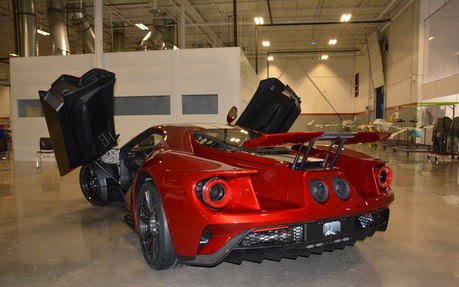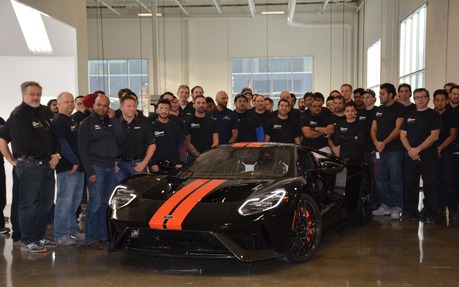First 2017 Ford GT Rolls off the Line in Canada
MARKHAM, Ontario – The history of the Ford GT plays out like an action-packed dramatic movie filled with suspense, revenge and glory.
It all started in the early '60s, when Enzo Ferrari, the founder of the iconic racing brand, backtracked from a deal to sell his company to Ford. Those actions sent Henry Ford II on a mission to beat Ferrari where it hurts the most—at the race track. It wouldn't be just at any race track, we're talking sweeping the podium at the famous 24 Hours of Le Mans in 1966.
Those were the building blocks of the Ford GT, then known as the “GT40.” This mid-engine, two-seater halo car would become a story of legends, eventually to be recreated as a limited-production car in 2005 for two years, and now again for a third time in 2016, recreating itself as a modern interpretation of the original GT40.
As I stand at Multimatic Inc., the automotive engineering and manufacturing specialists based in Markham, Ontario, and the building centre of the all-new 2017 Ford GT, it's astonishing to see the love and passion from the employees as the first production GT rolls off the line. This unit decked in a glossy black paint and orange striping will go to William Clay Ford Jr., the great grandson of Henry Ford and the current executive chairman of Ford Motor Company.
Immediately, the detail and precision that went into this supercar is overwhelming. The angles and cuts ooze performance; while the LED headlights and rear exhausts showcase masterful works of art.
It's a shame that only 1000 units will be produced globally over a span of four years, but that's part of the GT's rare, almost-unattainable charm. The limitations to units were similar back in '05 with only 4000-plus units produced over a two-year period.
“This is indeed the supercar we needed to build, without any excuses,” explains Raj Nair, Ford executive vice president, global product development, and chief technical officer.
“This not only has been a great achievement for Ford and its loyal GT customers, but a great program for learning about our own technologies and capabilities, as well as how those practices can filter down to the rest of our lineup,” adds Nair.
The on-road production of the GT is only half the reason Ford brought it back in the fold. The other side of it is rekindling its past racing glories, and it wasted no time doing that by winning the GTE Pro racing class at the 24 Hours of Le Mans in June 2016, 50 years after its incredible 1966 triumph.
“When we kicked off 2016, we had two primary objectives for our Ford GT supercar; to excel at Le Mans, and to start deliveries before year-end,” says Raj Nair. “We’ve achieved both.”
A talking point of the 2017 GT comes down to its twin-turbo, 3.5-litre EcoBoost V6 engine. It definitely looks small in the see-through case right behind the cockpit tub, but it packs a lot of punch using direct injection to muster 600 horses of action in a lightweight, mostly carbon fibre makeup that's matched to a seven-speed, dual-clutch automatic transmission. It's capable of achieving a 0-100 km/h sprint in three seconds with a top speed over 320 km/h.

The engine in the 2017 Ford GT puts an exclamation mark on the changing times, with only a mid-mount position staying the same from the past. A decade ago, there would never be talk of downsizing an engine in a supercar. That would be just heresy. In today's world, it's all about finding that balance between power and weight with ultra-efficient aerodynamics always in mind, and that decision to go with a V6 only took a matter of months after project approval.
“The all-new Ford GT is a showcase of our strength in innovation and our commitment to delivering more for our customers—especially related to lightweight materials, aerodynamics and EcoBoost engine technologies,” says Nair.
As of right now, there isn't an exact Canadian price—a price close to USD$450,000 was mentioned, to be on par with the Lamborghini Aventador. In addition, the allocation of cars to Canadian customers hasn't been reported, but as Nair puts it, “we allocated GTs globally based on matching our sales distribution.”
For now, Multimatic will start the process of building one GT a day, with a total of 6000 total parts to play with between 85 workers that are spread out between seven various stations. It's the biggest undertaking to date from the Canadian company, who have a lot of experiences in the racing world including working with the likes of Aston Martin, Mercedes, IndyCar and Formula One.
Considering that the GT is the closest thing to a racing car on the road, Ford has placed its halo car in good hands. Now, the biggest challenge will be to actually get your hands on one of these rare specimens to see how it drives.
